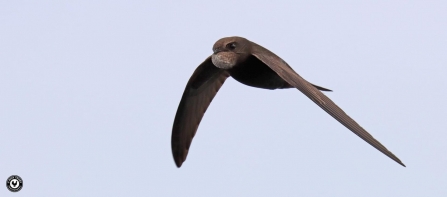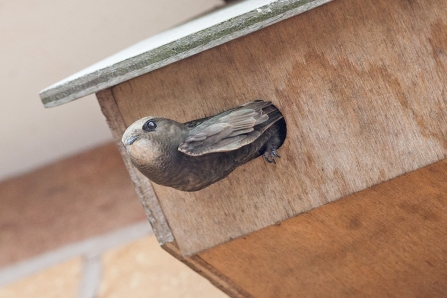Swifts are incredibly aerial birds, living entirely on the wing for months and even years at a time. They catch all their food in the air: aphids, flies, tiny spiders, small beetles and mayflies, all whirled into the sky and carried up high on the wind. They also preen, drink, bathe, sleep and mate in the air! They only land at their nests.
Raising Awareness of a bird in danger

This swift has its throat full of insects to take back to its chick. (C) Nick Truby
They spend most of their lives in Africa, journeying thousands of miles north when they migrate here to breed with us between May and August. You may wonder why these well-travelled birds come to the UK when so many of our summer days are rain-soaked, making it difficult to catch the insects they need to feed their young. In fact, our northern summers have the great advantage for swifts and other insect-eating birds in that they can feed throughout the sixteen hours of daylight we enjoy in mid-summer.
Swifts have several unusual adaptations that enable them to cope with spells of bad weather. The embryos and chicks of most small birds will quickly die if allowed to chill. By contrast, swift embryos, once partly developed, are resistant to cooling and in addition, chicks can become torpid (a state of lowered metabolism) to conserve energy when the weather turns cold and wet. This enables the parent birds to feed elsewhere, until the sunshine returns.
Once they are a few weeks old and have fat reserves, swift chicks can survive several days without nourishment, greatly enhancing their chances of fledging in our very variable summer weather conditions.

(C) Simon Richardson
Home sweet home
Swifts make their nests in crevices in walls, under roof eaves or occasionally among slates or tiles where there are small gaps. They leave no external signs of their occupancy. Gathering nest materials takes time – as all the feathers, wisps of grass, tree seeds and flower sepals must be found on the wing, blowing about in the air. Inevitably these days, scraps of plastic are now often found woven into the nest - a flimsy, shallow dish that is glued together with the birds’ saliva.
Finding an unoccupied nesting hole is the most crucial thing a swift has to do. Most individuals do not breed until their fourth year, but the young birds still make the migration journey and start looking for a safe, dark hole. Once they have found one, the young birds pair up and start to bring in feathers and other nest materials.
The apparent joie de vivre of swifts is breath taking. You hear them before you see them, screeching over the rooftops in gangs of seven or eight, racing circuits around buildings on fine summer nights.
As the poet Ted Hughes put it:
Their lunatic, limber scramming frenzy
And their whirling blades
Sparkle out into blue,
....They’ve made it again,
Which means the globe’s still working,
the Creation’s
Still waking refreshed, our summer’s
Still all to come
This anxiety about whether or not ‘our’ swifts will return each May is something most swift-watchers can relate to. However concerns have escalated since Ted Hughes’s poem was published 40 years ago, with an alarming 57% decline in numbers in the UK recorded between 1995 and 2017.
For thousands of years, swifts have lived alongside us, because the homes and other buildings we constructed for ourselves have also suited them. Today though, we are making it much harder for these birds to survive. While reduced abundance of insects may well be another contributing factor, swifts are also up against a catastrophic loss of nesting cavities.
Renovation of old buildings almost always results in access to their holes being blocked, while new housing tends to be sealed completely against nature. Modern building materials, such as plastic soffits (part of the eaves), offer little potential for future weathering and gaps opening up. We need to accommodate nesting swifts – and urgently.
Meet the swift champions
Thankfully, an inspirational movement of swift champions is coming to the rescue across the UK. More than 90 small groups are taking action locally. We have four in this county already in Chaddesden (Derby), Hathersage, Tideswell and Bradwell.
They run surveys to find swift breeding sites, work to prevent nesting holes from being blocked, install nest boxes, share information and help raise awareness through walks and talks especially during the annual Swift Awareness Weeks.
This year it is not possible to run guided walks or talks. So we are focusing on a programme of general awareness raising during the week via social media, blogs like this and articles in community magazines etc.

Swift boxes painted by the children of N Wingfield Primary using the colours of the flags of the African countries the birds fly over on migration.
If you want to learn more about these magic birds or you think they nest near you please get in touch by phoning 01773 881188 or emailing swifts@derbyshirewt.co.uk . The Derbyshire Swift Conservation Project attempts to raise awareness across the county, encourage the installation of nest boxes, the reporting of swift colonies and the setting up of local swift support groups.
Follow @swiftsweek and #swiftawarenessweek for more details.
